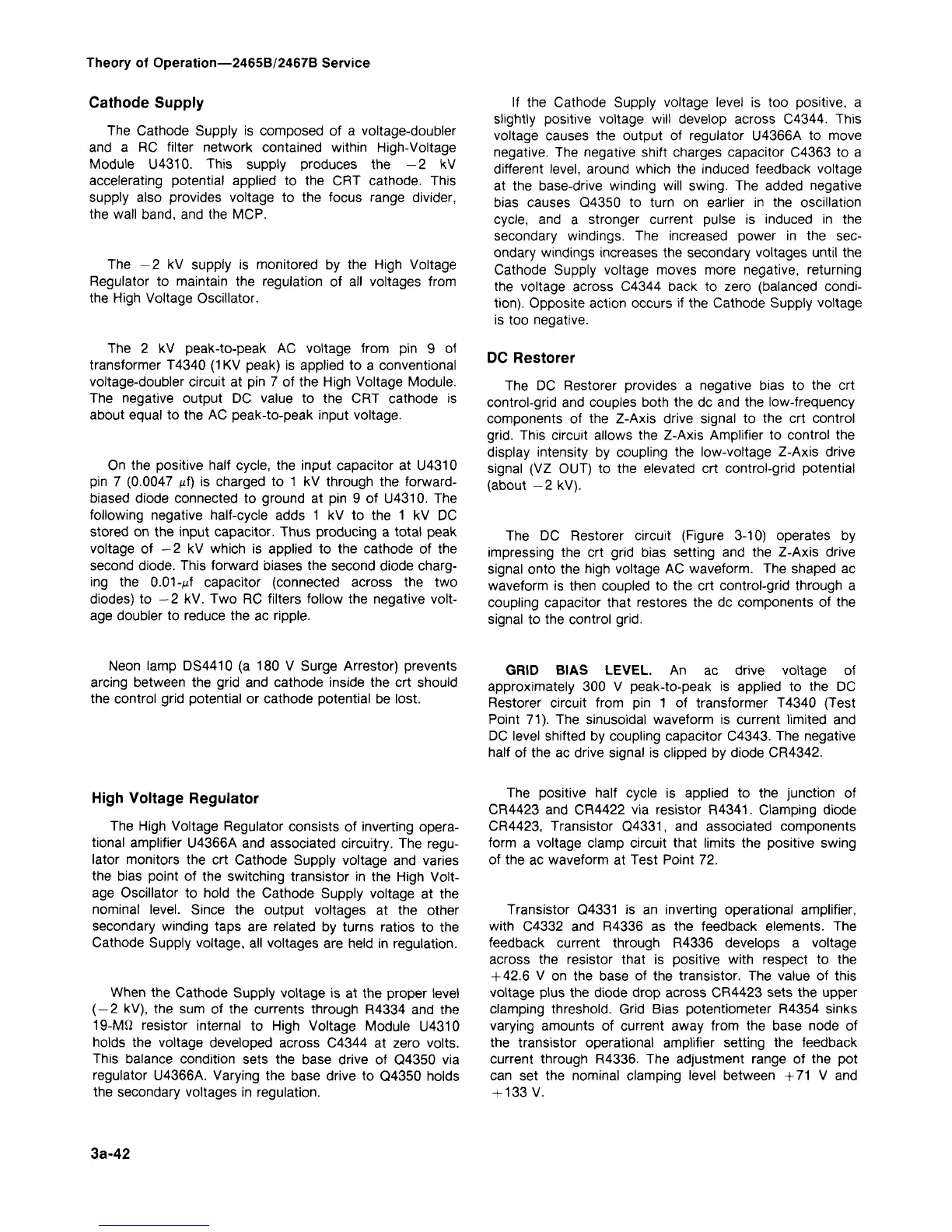Theory of Operation—2465B/2467B Service
Cathode Supply
The Cathode Supply is composed of a voltage-doubler
and a RC filter network contained within High-Voltage
Module U4310. This supply produces the -2 kV
accelerating potential applied to the CRT cathode. This
supply also provides voltage to the focus range divider,
the wall band, and the MCP.
The -2 kV supply is monitored by the High Voltage
Regulator to maintain the regulation of all voltages from
the High Voltage Oscillator.
The 2 kV peak-to-peak AC voltage from pin 9 of
transformer T4340
(1
KV peak) is applied to a conventional
voltage-doubler circuit at pin 7 of the High Voltage Module.
The negative output DC value to the CRT cathode is
about equal to the AC peak-to-peak input voltage.
On the positive half cycle, the input capacitor at U4310
pin 7 (0.0047 nf) is charged to 1 kV through the forward-
biased diode connected to ground at pin 9 of U4310. The
following negative half-cycle adds 1 kV to the 1 kV DC
stored on the input capacitor. Thus producing a total peak
voltage of -2 kV which is applied to the cathode of the
second diode. This forward biases the second diode charg-
ing the 0.01-Aif capacitor (connected across the two
diodes) to -2 kV. Two RC filters follow the negative volt-
age doubler to reduce the ac ripple.
Neon lamp DS4410 (a 180 V Surge Arrestor) prevents
arcing between the grid and cathode inside the crt should
the control grid potential or cathode potential be lost.
High Voltage Regulator
The High Voltage Regulator consists of inverting opera-
tional amplifier U4366A and associated circuitry. The
regu-
lator monitors the crt Cathode Supply voltage and varies
the bias point of the switching transistor in the High Volt-
age Oscillator to hold the Cathode Supply voltage at the
nominal level. Since the output voltages at the other
secondary winding taps are related by turns ratios to the
Cathode Supply voltage, all voltages are held in regulation.
When the Cathode Supply voltage is at the proper level
(-2 kV), the sum of the currents through R4334 and the
19-Mfl resistor internal to High Voltage Module U4310
holds the voltage developed across C4344 at zero volts.
This balance condition sets the base drive of Q4350 via
regulator U4366A. Varying the base drive to Q4350 holds
the secondary voltages in regulation.
If the Cathode Supply voltage level is too positive, a
slightly positive voltage will develop across C4344. This
voltage causes the output of regulator U4366A to move
negative. The negative shift charges capacitor C4363 to a
different level, around which the induced feedback voltage
at the base-drive winding will swing. The added negative
bias causes Q4350 to turn on earlier in the oscillation
cycle,
and a stronger current pulse is induced in the
secondary windings. The increased power in the sec-
ondary windings increases the secondary voltages until the
Cathode Supply voltage moves more negative, returning
the voltage across C4344 back to zero (balanced condi-
tion).
Opposite action occurs if the Cathode Supply voltage
is too negative.
DC Restorer
The DC Restorer provides a negative bias to the crt
control-grid and couples both the dc and the low-frequency
components of the Z-Axis drive signal to the crt control
grid.
This circuit allows the Z-Axis Amplifier to control the
display intensity by coupling the low-voltage Z-Axis drive
signal (VZ OUT) to the elevated crt control-grid potential
(about -2 kV).
The DC Restorer circuit (Figure 3-10) operates by
impressing the crt grid bias setting and the Z-Axis drive
signal onto the high voltage AC waveform. The shaped ac
waveform is then coupled to the crt control-grid through a
coupling capacitor that restores the dc components of the
signal to the control
grid.
GRID BIAS LEVEL. An ac drive voltage of
approximately 300 V peak-to-peak is applied to the DC
Restorer circuit from pin 1 of transformer T4340 (Test
Point 71). The sinusoidal waveform is current limited and
DC level shifted by coupling capacitor C4343. The negative
half of the ac drive signal is clipped by diode CR4342.
The positive half cycle is applied to the junction of
CR4423 and CR4422 via resistor
R4341.
Clamping diode
CR4423, Transistor
Q4331,
and associated components
form a voltage clamp circuit that limits the positive swing
of the ac waveform at Test Point 72.
Transistor Q4331 is an inverting operational amplifier,
with C4332 and R4336 as the feedback elements. The
feedback current through R4336 develops a voltage
across the resistor that is positive with respect to the
+ 42.6 V on the base of the transistor. The value of this
voltage plus the diode drop across CR4423 sets the upper
clamping threshold. Grid Bias potentiometer R4354 sinks
varying amounts of current away from the base node of
the transistor operational amplifier setting the feedback
current through R4336. The adjustment range of the pot
can set the nominal clamping level between +71 V and
+
133
V.
3a-42

